Otherwise known as “Shoulda, Coulda, Woulda” number 2.
Though I generally share everything harp guitar related in my orbit with you all, I do have the occasional “secret project” I’m working on (secret only until I’m ready for the reveal). This one might have been spectacular, I think…but alas, destiny decided otherwise. I’d actually put it completely out of my mind – but stumbled upon my old files the other day, and thought it might be time to tell the tale.
Through the years, I’ve naturally noodled on John Doan’s Sullivan-Elliott 20-string harp guitar and other sundry “super treble” harp guitars. I remember once (it must have been the 2nd Harp Guitar Gathering) attempting to ad-lib something on John’s instrument in front of a few Round Robin players. I recall Steve Bissell saying something like “Hey, this may be the first time a harp guitar is being played by an actual harpist!” He was alluding to the fact that, pre-Gathering, I played the harp (and once quite well, I might add). So it was then somewhat ironic that I so sucked at John’s super-treble guitar. It turns out – as discussed in “Zither-Guitars” and other blogs of mine – that super-trebles are really fretless zither strings. Compared to a harp, they’re backwards, on the wrong plane, and require a fairly different technique. And while they’re in the same orientation as FZs and Ukrainian banduras, which I also play(ed), again, the playing position is something different and specific.
Still, I pride myself on being a multi-instrumentalist, so when this fantastic Milburn harp guitar came through on consignment in 2007, I decided to give “the tinklies” one last, serious shot.

And still, I just didn’t dig it. And I figured out why.
It wasn’t just the limited melodic range (with just 8 supers, no matter what tune I seemed to try, I’d invariably run out of harp melody strings) – it was my visual struggle with these thin metal wires floating over a blonde piece of wood. I’m generally not an eyes-closed player of anything (other than, coincidentally, the bandura), and apparently need a decent visual reference system.
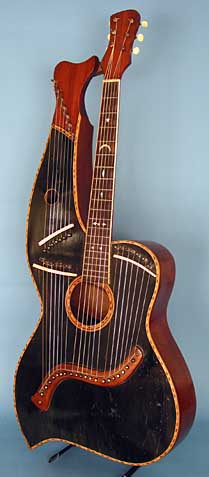
Cut to a couple months later (the Milburn now sold), when I was working on my Harp Guitar Dreams piece on the Knutsen “zither harp guitar” (at right). I was not only comfortable with it (difficulty aside), I was enjoying it. Why that, and not the Milburn?
You can see the answer yourself in these photos. I realized that it was simply because it had a black top. I could see all the treble strings in high contrast, which (to me) made all the difference in having playing security and confidence.
After having to Frankenstein-modify my precious instrument to get it to play in tune and survive the months of tension for this tricky project, I subsequently decided (kind of like John with his Knutsen 18-string > Sullivan-Elliott) that I should get a modern, professional version of my unique Knutsen.
Brainstorming through the list of my luthier friends, I realized that the person best suited to tackle it – it would hypothetically include many upgrades and clever additions (I remember much custom milling and even pneumatics entering into it at one point) – would be Mike Doolin.
Knowing nothing of my ideas and goals, beyond that “it will be the most challenging thing you’ve ever done,” Mike accepted the commission and I gave him a down payment in 2008. I was especially excited that, among other things, we would be creating the first contemporary black-top harp guitar.
True. At the time, only vintage Knutsen and Gibsons had been seen with this telltale feature – which I’ve always loved.
Maddeningly, as I impatiently waited for Mike’s waiting list to shorten, someone beat me to a black-top: Mike, himself! Not yet privy to my plans, he made this thinline electric-acoustic harp guitar for his wife Nancy late in 2008:

The cat was out of the bag. The next thing I knew, Duane Noble – inspired by Knutsen – had his own black-top in the works:
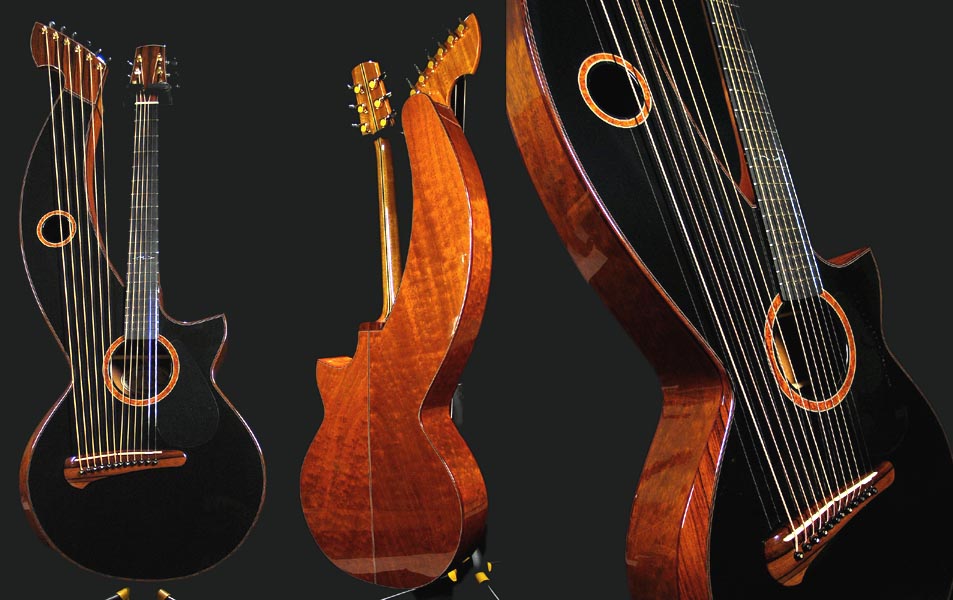
When I next saw John Doan show up at HGG8 in Indianapolis with his own “secret project” – a black top Brunner travel harp guitar – that was it; I knew I’d be looking like Joe Loser, late-to-the-party, if and when Mike ever got to my damn instrument!

Meanwhile… Mike had surprised us all with this little nugget:
“I’m retiring from building.”
He assured me that he was still going to finish a couple more instruments, and that mine would be his last commission.
As the many months wore on, I put it out of my mind, concentrating on other projects and pleasant distractions like the parade of vintage discoveries that inexorably wend their way to the Miner Museum.
By the morning of the final breakfast at last year’s Gathering in Hamden, CT, I guess I had subconsciously already come to the realization that the award-winning Doolin GM-model zither harp guitar was an idea whose time had come and gone. When Mike quietly sat down at my table, I immediately read his own mind – even before he privately slipped me my deposit refund. We felt a mutual combination of regret and relief. The project would have been time-consuming and difficult, a labor of love/hate that probably would have stretched the limits of our own friendship.
But it would have been awesome.
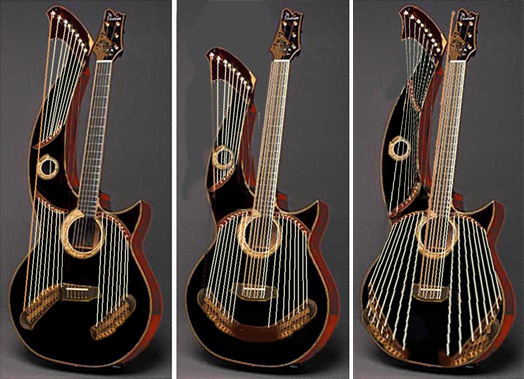
Some of my many mock-ups as I brainstormed the possible configurations of stringing possibilities.

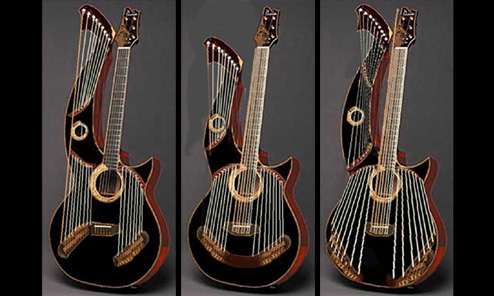
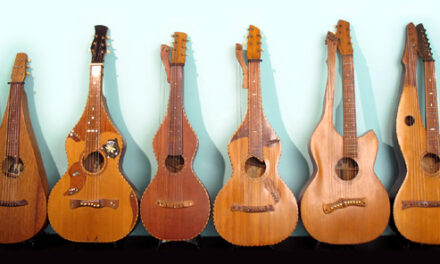
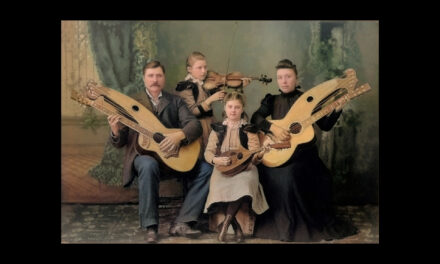
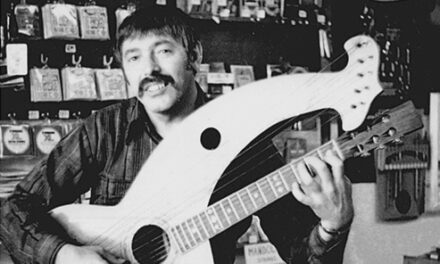
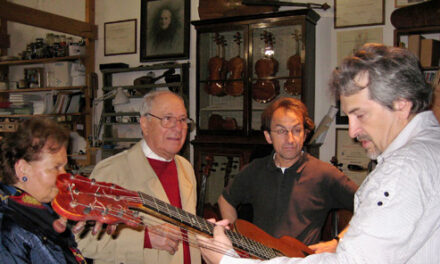
Could be a fun project 🙂
Gregg-Dude!!
I can only hope that I was on that list of luthiers that Doolin topped! I wish it had happened…it would have been a wonderful addition to the HG world. But, since you don’t have to shell out for that beauty…well….The Humanitar is still available…..
Maybe I could put a little black paint on it?
Love ya’!
Fred
Maybe a Tenor Uke/Pixie Harp version would be fun to try first.
Yesterday an old friend of James Klein popped in to try out a harp guitar.
Thierry Hercod, he plays amongst other things ,the Ukranian banduara. So many strings! Sounded lovely
Fascinating object as well. Very close to the harp guitar, with the bass strings played with the left hand in an upright position.
Oddly, your harp guitar doesn’t touch me, visually it’s not my thing, but the idea is intriguing.
Dam it! I won’t sleep tonight.
Hah! Sean, if nylon and not black, perhaps should build me a practical version of this one: https://www.harpguitars.net/history/month_hg/month-hg.htm
I will definitely make one, perhaps not black and probably nylon string.
This is wicked of you Gregg. I can hear the guitar in my head…I was just getting excited about harpolyres and now I’m dreaming of “zither guitars”.
Don’t say ‘Never’ Greg. I was ‘never’ going to build another AVC and then I did. I think zither guitars will be the next big thing!
Very nice those two tracks. To my ears it sounds like it makes sense. After making my 18 string, i had the feeling that 6 super trebles were just not enough. I love those full chords, the ultra middles blend better with the guitar chords.
The sustain and resonances are wonderful. Just discovered a new world.
Clever and inspiring chap that Knutsen!!
Found the answers to my questions on the mp3download page .
Sounds lovely.
Thanks, Sean − I had forgotten all about that. I left the explanatory info, but removed the download, as I’ve recently re-mixed/mastered it for my upcoming all-Knutsen CD (slow, but steady now).
Yes, (glad someone’s been reading), the ZHG’s 3 banks are tuned to chords (they’re not really “super-trebles,” more like “ultra-middles”). If you listen to “Bridge of Verdant Mist” and “Total Eclipse,” you’ll hear different full chords, partial chords and complex melodies (imagine a large spider playing the instrument). The modern ZHG could theoretically be tuned nominally to scales, but…well, bear in mind my background.
Hi Gregg. Completely crazy project…. but what would the treble bank tunings be?
I read in your article on the hgs40 that they are tuned to chords.
Out of all the projects I seem to prefer the original Knutsen.
Michael, I appreciate your enthusiasm and optimism, but I highly doubt we’ll see the response you’re describing. And like I said, I think the time for me has passed on this creation. Seriously – I’ve got one more recorded tune planned for the Knutsen ZHG, then time to move on to other things. That being said, I’m not letting you off the hook that easy!
And trust me, this is not an idea for “improvements for future harp guitars”; it was my own wacky take on another one-off invention for my own esoteric musical ideas.
Let’s wait and sift through the few dozen responses we are going to get here.
Actually, I have wanted to ask you what improvements or features you would like to see in future Harp Guitars. Then I was going to build it…For ME. I would never be able to play your “true harp guitar” so maybe I would make the attempt to build it. I have names in mind of others who could do this for you but if no takers, you can keep me wayyyy in the back of your mind but don’t think of this as any kind of commitment. This message will self-destruct in 10.. 9.. 8..7…
PS If you are adding elektrifing, I don’t know anything about elektriks
Hmmm, do I sense a foolish volunteer?
First thing is to settle on your requirements including gauges, tunings, string lengths and placement. Maybe a few builders (the ones who build for fun not profit) would take up the challenge and make this dream a reality (no commission). Instead of the BLUE jazz guitar this one will be the BLACK “true harp guitar”. Have a designer like Elliott for Sullivan draw up and share the plan. Then someone will build it (for fun not profit). I feel that this project is impossible if the requirements are not set in stone before the building begins. The designer/engineer is the key. Then you could buy the best of the several dozen “true harp guitar” prototypes.
Michael